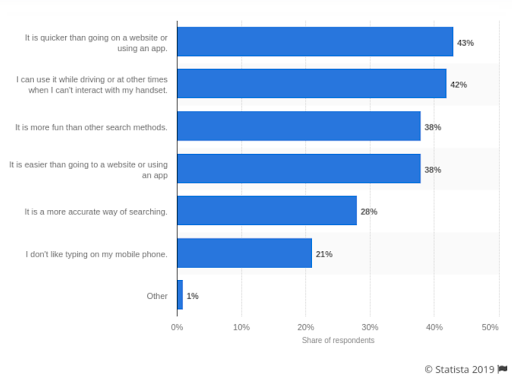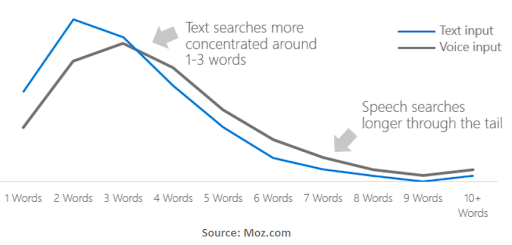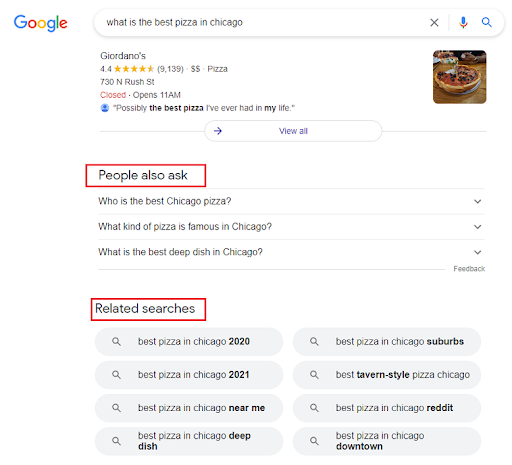Back in 2016, voice search optimisation had been on SEO specialists’ lips already. They called it the “next big thing,” encouraging colleagues to start optimising their websites for voice search.
Today, we don’t consider voice search anything special. It’s a must for those willing to get websites to the first page of Google’s SERPs. And it’s especially true for the eCommerce niche: promoting and selling products, they want users to see them in search results as high as possible.
User behaviour and the way they search for information online have drastically changed over the years: AI technologies grow, smartphones embed voice assistants (OK, Google and Siri are just to name a few), and now it’s more comfortable for people to search by voice than typing.
What does it mean for your business? What can you do to make search engines “see” your product pages as relevant to voice search queries? How to optimise product descriptions for voice search in 2021?
In this post, you’ll find the answers.
But first things first:
What is voice search?
Voice search is the process of getting access to search results via a smartphone, using your voice instead of typing keywords in a search tab. A user tells what they want to get, and a search engine, a smart speaker, or a voice assistant provides the answer. In short, it’s a human-machine interaction where a device answers spoken search queries.
More and more users give preference to voice search today:
- It’s more comfortable than typing
- It’s more efficient, providing precise answers to user questions

How does it work?
Search platforms analyse your words and reply with responses resembling natural language. Alexa, Siri, Cortana, and Google are examples of voice search platforms that satisfy user search intent.
What does it all have to do with your online business?
Why consider voice search when writing product descriptions
Voice search calls the shots today, influencing all website and social media metrics. It changes the whole game for SEO specialists and marketers. Let this sink in:
- Voice search already has over $2 billion worth of sales, and 71% of consumers today prefer voice search to traditional typing.
- The number of voice assistants in use is about to reach 8.4 billion by 2024, and it’s a part of a daily routine for people to use them for finding local businesses and buying online.
Now, if you don’t want to miss customers and high rankings for your online business in search engines, it’s time to optimise product pages and descriptions accordingly.
How to optimise product descriptions for voice search
As an SEO and marketing specialist, you need to “help” voice assistants recognize your product descriptions as those most relevant to a user voice query. For that, it would help if you understood the core difference between voice- and traditional search:
Voice search is conversational. When speaking to a device, people generally use longer keywords and ask whole questions instead of a couple of words. They are more likely to say, “OK, Google, where can I find the cheapest pizza near me?” than “cheapest pizza Chicago.”

Also, remember about voice search ranking factors:
- User search intent: your content needs to match a particular type of user intent (informational, navigational, transactional, or commercial) and satisfy it;
- Featured snippets: pages that appear in Goggle’s snippets are more likely to get to voice search results too;
- Local content: as far as 22% of voice queries are about local content, do your best to optimise yours for “near me” and your business location queries;
- Length and word count: voice search favors shorter answers (29 words on average), so be precise when crafting your content; Google also extracts voice search results from long-form content (2,000+ words), so optimise your pages accordingly;
- Long-tail keywords: optimising your product descriptions and any other content type for long-tail keywords, you get more chances to appear in voice search;
- Readability: Google loves easy-to-read content, so make yours written at the 9th grade or so;
- Page load speed: the faster, the better.
Given that, here’s what you can do with your product description optimisation right now:
Make product descriptions scannable
Voice search is more about getting results on mobile devices, so people expect respectively-optimised content.
Write product descriptions that are easy to scan on mobile:
- Use short sentences and paragraphs.
- Consider lists (more on that below).
- Make headers bold.
- Break up text blocks as much as you can.
At the same time, ensure that any popups or ad blocks don’t break up your product descriptions. Users won’t appreciate walls of text in answer to their precise queries.
Optimise for long-tail keywords, related terms, and concepts
People are more conversational when it comes to voice search, so they use whole questions or long-tail keywords for queries. So it would help if you optimised product descriptions for common questions and build your content around that:
Consider keywords that are as close to natural speech as possible.
Ask yourself, “What questions would people ask that would lead them to my page?” and provide answers in product descriptions.
Remember about Google- and YouTube autocomplete suggestions: There can be some of the most common searches to include in your content.
You can also automate this process and use corresponding tools for long-tail keywords search: Ahrefs, SEMRush, Moz Keyword Explorer, etc.
Also, remember that search engines are smart enough today to understand the context. They use semantic analysis and machine learning to understand the intent behind each spoken query. To make them “see” your page as the most relevant one, optimise descriptions with related terms applying to your product. Tools like TextOptimise or LSI Graph can help with that.
Consider local search if applicable
As you know, most users consider voice search for local information. If this applies to your business type, remember to optimise all the information accordingly:
- Include keywords specifying your location: “pizza in Chicago,” “best florist in Miami,” etc.
- Use Google My Business to specify all your localized information: It will help your product pages rank better for “near me” types of keywords.
Use headings, lists, and tables
Don’t hesitate to structure your product descriptions with H2 and H3 headings. It will help search engines understand its structure and feature it for corresponding voice search queries. Remember to include relevant keywords in titles.
Tools like Serpstat Text Analysis can help you understand how to structure page content better. Once provided with your query, it will analyse competitors’ content and give you actionable suggestions on what you can do to outperform them.
Besides headings, consider optimising your product descriptions with lists and tables. Not only does it improve the readability and scannability of your content, but it also helps your page get featured higher:
Google will extract short answers to voice search queries from your long content and feature them as snippets.
Add product Q & A
Voice searches are often direct questions, so why not add them and provide users with answers on your product description page? Consider 5W + H: who, what, where, when, why, and how.
Related question-based keywords from your keyword explorer tool can help you start. Also, check Related Searches and People Also Ask sections in Google:

Tools like Answer the Public can provide you with dozens of questions about a particular keyword too.
Add product schema
In 2018, Brian Dean from Backlinko analysed 10,000 Google home search results and distinguished that 36.4% of voice search results originated from pages using Schema.org.
That’s because it helps search engines better understand and interpret your page results faster, providing it as an answer to a user query. And if it’s a digital voice assistant who reads this answer, preventing a user from further searches, your chances for conversion will go sky-high.
You can integrate Schema.org with your website via tools like Schema App or plugins like Wiremo, Site Reviews, and others.
In a word
The world is changing rapidly today: Trends come and go, new technologies grow, and they influence how (and what) we search online. For online businesses to stay afloat and thrive, it’s critical to keep up with the times and adjust their marketing strategies accordingly.
With voice search on its rise, your website SEO may need slight changes for maximum results. If not sure what details to optimise and how to do that right, you can always ask for the professional help from SEO specialists. After all, those who try — win, right?
Author Bio
Lesley Vos is a professional copywriter and guest contributor to publications on digital marketing. Specializing in data research, web text building, and content promotion, she is in love with words, non-fiction literature, and jazz. Feel free to see more works of hers in the portfolio.






Leave A Comment